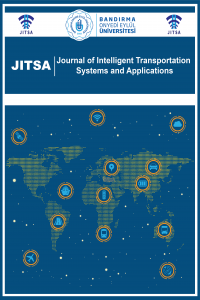Kavşak yaklaşımında araçların A-sütunlarının önemi
Trafik güvenliği, A-sütunu, kör nokta
Importance of A-pillars of vehicles during intersection approach
Traffic safety, A-Pillar, blind spot,
___
- AlMamlook, R. E., Kwayu, K. M., Alkasisbeh, M. R., and Frefer, A. A. (2019). Comparison of machine learning algorithms for predicting traffic accident severity. In 2019 IEEE Jordan International Joint Conference on Electrical Engineering and Information Technology (JEEIT), 272-276.
- Colling, D. A. (1990). Industrial safety: management and technology. Prentice Hall. Hakkert, S. and Mahalel, D. (1978). Estimating the number of accidents at intersections from a knowledge of the traffic flows on the approaches. Accident Analysis & Prevention, 10, 1, 69-79.
- International Traffic Safety Data and Analysis Group (Irtad), (2020). Road Safety Annual Report 2020. International Transport Forum.
- Karayolları Genel Müdürlüğü, (2020). Trafik kazaları özeti. kgm.gov.tr, https://www.kgm.gov.tr/SiteCollectionDocuments/KGMdocuments/Trafik/TrafikKazalariOzeti2017.pdf (Erişim tarihi: 3 Kasım 2020)
- Kashani, A.T. and Mohaymany, A.S. (2011) Analysis of the traffic injury severity on two-lane, two-way rural roads based on classification tree models, Safety Science, 49(10), 1314–1320.
- National Highway Traffic Safety Administration, (2020). Fatality and Injury Reporting System Tool (FIRST), United States Department of Transportation. https://cdan.dot.gov/query
- Özinal, Y. and Uz, V. E. (2021). Dönel Kavşak Geometrik Elemanlarının Kavşak Güvenliği Üzerine Etkisinin Literatür Işığında Değerlendirilmesi. Politeknik Dergisi. 24, 1, 283-297.
- World Health Organization, (2018). Global status report on road safety 2018: Summary (No. WHO/NMH/NVI/18.20). World Health Organization.
- ISSN: 2636-820X
- Yayın Aralığı: Yılda 2 Sayı
- Başlangıç: 2018
- Yayıncı: Bandırma Onyedi Eylül Üniversitesi
Şişli ilçesindeki trafik kazalarının coğrafi bilgi sistemleri ile incelenmesi
Mert ERSEN, Ali Hakan BÜYÜKLÜ, Semra ERPOLAT TAŞABAT
Dispeç Kaynaklı Aksaklıkların Diğer Operasyon Birimlerine Etkisi
Hasan SEMİZ, Ebru ARIKAN ÖZTÜRK
Yeni Nesil Mobil İletişim Sistemlerinin Gemi Kara Arasındaki Deniz Haberleşmesinde Kullanım Olanağı
Akıllı ulaşım sistemlerinde siber saldırılar ve önlemler
Kavşak yaklaşımında araçların A-sütunlarının önemi
Yolcuların raylı ulaşım sistemlerinden memnuniyetini etkileyen faktörler
Seydahmet ERCAN, Nezir AYDİN, Tuba Nur ASLAN
Togg’un pazarlama çevresinin değerlendirilmesi: PESTLE analizi
Kent Ulaşımında Mikromobilite Çözümlerine Lokasyon Analitiği Yaklaşımı
Gözde KARAHAN, Elif GARAGON, Ceren KURTULUŞ
Bağlantılı Mikromobilite Altyapısını Mevcut Toplu Taşıma Sistemine Entegrasyonu
